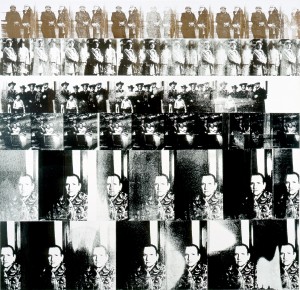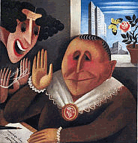
I took my third long walk through the exhibition, another treasure hunt. Again I was delighted to see how well Seeing Gertrude Stein: Five Stories is really SEEING her, seeing and responding and echoing her contemporary relevance. Pointing out: Stein has something to tell us — today! Just look and listen!
This time, I focused on the last part of the show, “Story 5: Legacies”, which is small but saftig. The art work prickles with invention and political zest. Andy Warhol’s color screen print “Gertrude Stein” from his 1980 series “Ten Portraits of Jews of the Twentieth Century” used the Vichy passport photo that Stein needed in 1940 when she returned from the country to Paris in order to save her Picasso portrait and other valuables in her apartment from the Germans. I wrote in a previous blog about black artist Glenn Ligon’s neon tubing “Warm Broad Glow”– and there it is, on its own wall, lighting up a the words “negro sunshine,” part of the phrase: “the warm broad glow of negro sunshine” from Stein’s early novella “Melanctha.” The story about the courtship of a black couple (published in Three Lives) was once considered the first portrait of black people written by a white author.
Terrie Berlier’s mixed media wall sculpture “Human Tuning Fork # 4” from 2004, made of 240 telephone speakers wired together, mutters and sputters Stein’s sybilline “anyone having been that one is the one that one is” in endless distortions in the languages of the countries involved in World War II.
Equally thought-provoking is Devorah Sperber’s “After Picasso” (2006), a montage of over 5,000 spools of thread, arranged on the wall in order to be viewed through a small glass sphere that inverts the image and composes the spools into Picasso’s portrait. The wall text tells us, “Sperber incorporates the mechanisms by which the brain makes sense of the visual world into the artistic experience she creates for her viewers.” I would add the tender association of the spools of thread with the needle-work of Alice that probably went on at home in a similarly continuous, steady stream as Gertrude’s writing.
Last but not least, part of the Legacies story greets us already at the entrance to the show in the large biographical silk print canvas by Deborah Kass from 1994/95, “Let Us Now Praise Famous Women # 3” (shown at the top of this blog post). Kass plays on Andy Warhol’s 1963 “pictobiography” of artist Robert Rauschenberg, titled “Let Us Now Praise Famous Men.” Standing guard at the entrance, it sets the tone in a non-didactic way, inciting visitors to reflect on Stein’s fame, the politics of gender, and the long-lasting impact of the language revolutionary who defied every stereotype – in literature as well as in her early-on established lesbian lifestyle.
The humorous approach by many artists chosen for the show is striking and inspiring. Humor takes the “literary Einstein of this century” (as Stein coined herself) down from her throne and makes her accessible and fun. Caricatures by David Levine target both Gertrude and Alice; cartoonist Tom Hachtman stands out with his “schizographic” double portrait “Gertrude Steinem” that gives Stein a feminist “make-over” by merging Picasso’s famous portrait of her with Gloria Steinem’s aviator glasses, long hair and the cigarette that Stein, too, used to smoke.
In my previous blog, I already featured the Stein caricature by pop artist Red Grooms who seated the icon in a flowery pop-up chair, making me wish for a children’s book by him, depicting the entire Paris Salon scene in pop-ups. But even much earlier, especially during her American Lecture Tour, Stein was met by tender mocking in the American press, from the New Yorker to Vanity Fair. The most hilarious parody, in Vanity Fair, pits air-head Gracie Allen (a character from a popular radio show) against Stein in Miguel Covarrubias’ caricature “Impossible Interview: Gracie Allen vs. Gertrude Stein. Gracie tries to enweigle Gert in a game of cats cradle – to no avail.

This is the accompanying dialogue between the two:
“Gertrude: “Is words. Is a style. Is a word is a style is words is not a style. Is buttons. Gracie (merrily): Aaaah-ah-aah, now, Gertie, I bet you say that to all the boys. Gertrude: Buttons is unbottoned. Trude is untrude. Stein is unstein. Gracie: Oh Gertie, you say the funniest things. I wish I could think of funny things to say like that. Gertrude: Is a word is two words is three words is prose. Gracie: It’s wonderful, the things you say. George read them to me in that book by Alice B. Toklas. Gertrude: I wrote that book. I am Toklas. Gracie: So am I, particularly on the soles of my feet. (…)”
Can it get any better than that?
Next we will walk across the block to SFMOMA where the monumental show The Steins Collect: Matisse, Picasso and the Parisian Avant-Garde has just opened, and maybe we’ll get an answer. Stay tuned.



